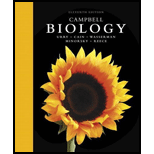
Campbell Biology (11th Edition)
11th Edition
ISBN: 9780134093413
Author: Lisa A. Urry, Michael L. Cain, Steven A. Wasserman, Peter V. Minorsky, Jane B. Reece
Publisher: PEARSON
expand_more
expand_more
format_list_bulleted
Concept explainers
Question
Chapter 32, Problem 32.1CR
Summary Introduction
To determine: The ways in which animal differ from the plants and
Introduction: Plants form the kingdom Plantae that includes all the trees, shrubs,
Expert Solution & Answer
Explanation of Solution
Animals differ from plants and fungi in following ways:
| Criteria | Animal | Plant | Fungi |
| Cellular structure | Animal cells do have cell wall, but other parts are present such as cilia, and tight junction. | Plant cells have cell wall chloroplast, plastids, plasmodesmata, and other organelles. | Fungi cells have membrane-bound nucleus, mitochondria, and a complex internal membrane. |
| Mode of nutrition | Heterotrophs | Autotrophs | Heterotrophs |
| Photosynthesis process | Absent | Present | Absent |
| Movement | Ability to move from one place to another freely. | Unable to move from one place to another. | Unable to move from one place to another. |
| Growth | Organs and organ system support the animal growth. | Plant growth occurs throughout the life. The meristematic system of the root tip and stem supports the plant growth. | In fungi, the fungal spores germinate and form hypae. |
| Response | Animal have proper nervous and sensory system. | Plants show response to the external stimuli like light and touch, but they do not have sensory system. | Fungi show response to the external stimuli like light and touch, but they do not have sensory system. |
Want to see more full solutions like this?
Subscribe now to access step-by-step solutions to millions of textbook problems written by subject matter experts!
Students have asked these similar questions
Please list five fundamental differences between plants and animals.
What is the hierarchy of complexity of an organism?
Could you explain and understand each complexity of organisms?
Atom, molecule, macromolecule, cell, tissue, organ, organ system, and organisms?
Describe the characteristics of animals that differentiate them from the other kingdoms of organisms.
Chapter 32 Solutions
Campbell Biology (11th Edition)
Ch. 32.1 - Summarize the main stages of animal development....Ch. 32.1 - WHAT IF? What animal characteristics would be...Ch. 32.2 - Put the following milestones in animal evolution...Ch. 32.2 - VISUAL SKILLS Explain what is represented by the...Ch. 32.2 - MAKE CONNECTIONS Evaluate whether the origin of...Ch. 32.3 - Distinguish the terms grade and clade.Ch. 32.3 - Compare three aspects of the early development of...Ch. 32.3 - Prob. 3CCCh. 32.4 - Prob. 1CCCh. 32.4 - WHAT IF? Suppose ctenophores are basal metazoans...
Ch. 32.4 - Prob. 3CCCh. 32 - Prob. 32.1CRCh. 32 - What caused ihe Cambrian exploston? Describe...Ch. 32 - Describe how body plans provide useful Information...Ch. 32 - Prob. 32.4CRCh. 32 - Prob. 1TYUCh. 32 - The distinction between sponges and other animal...Ch. 32 - Prob. 3TYUCh. 32 - Prob. 4TYUCh. 32 - EVOLUTION CONNECTION A professor begins a lecture...Ch. 32 - SCIENTIFIC INQUIRY INTERPRET THE DATA Redraw the...Ch. 32 - WRITE ABOUT A THEME: INTERACTIONS Animal life...Ch. 32 - SYNTHESIZE YOUR KNOWLEDGE This organism is an...
Knowledge Booster
Learn more about
Need a deep-dive on the concept behind this application? Look no further. Learn more about this topic, biology and related others by exploring similar questions and additional content below.Similar questions
- Describe 4 features that distinguish animals from other kinds of organismsarrow_forwardAccurately depict the evolutionary relationships among spiders, birds, porifera, homosapiens, lampreys, nematoda, tuna, clam and jellyfish by listing them in order from most closely related to most distantly related. Indicate where different types of body symmetry arise and where major evolutionary features originated in vertebrates.arrow_forwardList the three domains of living organisms, and describe the general characteristics of organisms included within each domain.arrow_forward
- Explain the characteristics that collectively distinguish animals from other kinds of organisms.arrow_forwardExplain the difference between a one-celled organism and a single cell of a multicelled organism. (Think in terms of classification and functionality)arrow_forwardList the 3 domains into which all organisms are placed.arrow_forward
arrow_back_ios
SEE MORE QUESTIONS
arrow_forward_ios
Recommended textbooks for you
 Biology Today and Tomorrow without Physiology (Mi...BiologyISBN:9781305117396Author:Cecie Starr, Christine Evers, Lisa StarrPublisher:Cengage Learning
Biology Today and Tomorrow without Physiology (Mi...BiologyISBN:9781305117396Author:Cecie Starr, Christine Evers, Lisa StarrPublisher:Cengage Learning Biology (MindTap Course List)BiologyISBN:9781337392938Author:Eldra Solomon, Charles Martin, Diana W. Martin, Linda R. BergPublisher:Cengage Learning
Biology (MindTap Course List)BiologyISBN:9781337392938Author:Eldra Solomon, Charles Martin, Diana W. Martin, Linda R. BergPublisher:Cengage Learning Biology: The Dynamic Science (MindTap Course List)BiologyISBN:9781305389892Author:Peter J. Russell, Paul E. Hertz, Beverly McMillanPublisher:Cengage Learning
Biology: The Dynamic Science (MindTap Course List)BiologyISBN:9781305389892Author:Peter J. Russell, Paul E. Hertz, Beverly McMillanPublisher:Cengage Learning Human Biology (MindTap Course List)BiologyISBN:9781305112100Author:Cecie Starr, Beverly McMillanPublisher:Cengage Learning
Human Biology (MindTap Course List)BiologyISBN:9781305112100Author:Cecie Starr, Beverly McMillanPublisher:Cengage Learning Concepts of BiologyBiologyISBN:9781938168116Author:Samantha Fowler, Rebecca Roush, James WisePublisher:OpenStax College
Concepts of BiologyBiologyISBN:9781938168116Author:Samantha Fowler, Rebecca Roush, James WisePublisher:OpenStax College

Biology Today and Tomorrow without Physiology (Mi...
Biology
ISBN:9781305117396
Author:Cecie Starr, Christine Evers, Lisa Starr
Publisher:Cengage Learning

Biology (MindTap Course List)
Biology
ISBN:9781337392938
Author:Eldra Solomon, Charles Martin, Diana W. Martin, Linda R. Berg
Publisher:Cengage Learning

Biology: The Dynamic Science (MindTap Course List)
Biology
ISBN:9781305389892
Author:Peter J. Russell, Paul E. Hertz, Beverly McMillan
Publisher:Cengage Learning

Human Biology (MindTap Course List)
Biology
ISBN:9781305112100
Author:Cecie Starr, Beverly McMillan
Publisher:Cengage Learning

Concepts of Biology
Biology
ISBN:9781938168116
Author:Samantha Fowler, Rebecca Roush, James Wise
Publisher:OpenStax College
